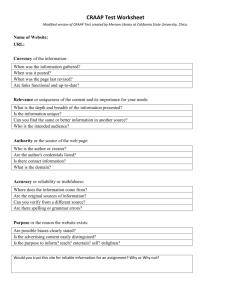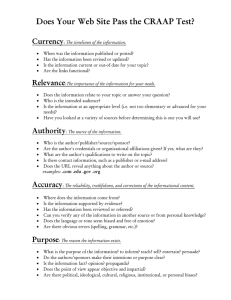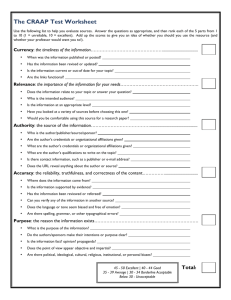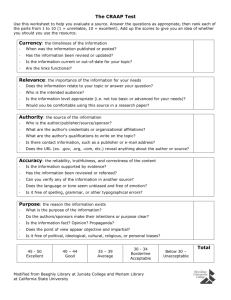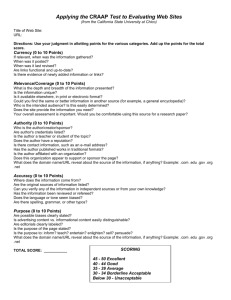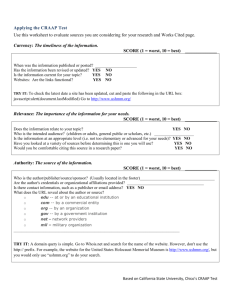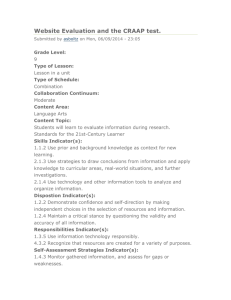Corporate Social Responsibility - Clackamas Career and Technical
advertisement
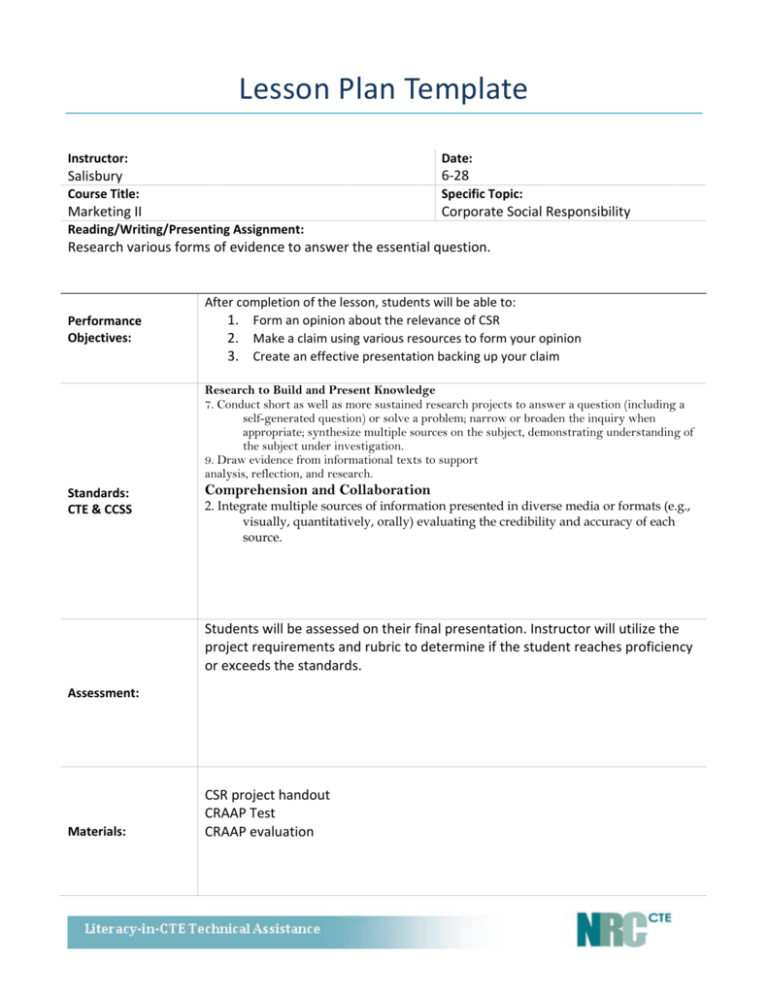
Lesson Plan Template Instructor: Date: Salisbury 6‐28 Course Title: Specific Topic: Marketing II Corporate Social Responsibility Reading/Writing/Presenting Assignment: Research various forms of evidence to answer the essential question. Performance Objectives: After completion of the lesson, students will be able to: 1. Form an opinion about the relevance of CSR 2. Make a claim using various resources to form your opinion 3. Create an effective presentation backing up your claim Research to Build and Present Knowledge 7. Conduct short as well as more sustained research projects to answer a question (including a self-generated question) or solve a problem; narrow or broaden the inquiry when appropriate; synthesize multiple sources on the subject, demonstrating understanding of the subject under investigation. 9. Draw evidence from informational texts to support analysis, reflection, and research. Standards: CTE & CCSS Assessment: Materials: Comprehension and Collaboration 2. Integrate multiple sources of information presented in diverse media or formats (e.g., visually, quantitatively, orally) evaluating the credibility and accuracy of each source. Students will be assessed on their final presentation. Instructor will utilize the project requirements and rubric to determine if the student reaches proficiency or exceeds the standards. CSR project handout CRAAP Test CRAAP evaluation Procedure: Literacy Strategy used: CRAAP Test CRAAP Evaluation Entire Class: Introduction and Method of activating prior knowledge – We will discuss the four areas of CSR and draw on prior knowledge to discuss what the four areas are and what they mean. Individual: Complete the prior research necessary to have the knowledge of CSR and what it means. Group: Fulfill the project requirements with a partner Entire Class: Students will use this information to become more aware consumers and educated evaluators of companies. Application of Material: Extension Questions: Accommodations needed: CorporateSocialResponsibility FinalAssessment MarketingII Answerthefollowingquestions: 1. List,defineandgiveanexampleforeachofthefourcategoriesofCSR. 2. IftheschoolwereacompanyexplainhowTualatinHighSchoolcould incorporatethefourcategoriesofCSRintoourdailyoperationstobecome moresociallyresponsible. 3. Outofallthepresentations,whosedoyourememberthemost?Why? 4. Doyoupersonallybelievecorporationshaveanobligationtobettersociety? Whyorwhynot? 5. Whatdidyoulikebestaboutthisunit?Whatdidyoulikeleast? 6. Onascaleof1‐10(1beingnothingand10beingalot),howmuchdidyou learnduringthisunit? CorporateSocialResponsibility FinalAssessment MarketingII Answerthefollowingquestions: 1. List,defineandgiveanexampleforeachofthefourcategoriesofCSR. 2. IftheschoolwereacompanyexplainhowTualatinHighSchoolcould incorporatethefourcategoriesofCSRintoourdailyoperationstobecome moresociallyresponsible. 3. Outofallthepresentations,whosedoyourememberthemost?Why? 4. Doyoupersonallybelievecorporationshaveanobligationtobettersociety? Whyorwhynot? 5. Whatdidyoulikebestaboutthisunit?Whatdidyoulikeleast? 6. Onascaleof1‐10(1beingnothingand10beingalot),howmuchdidyou learnduringthisunit? Applying the CRAAP Test to Evaluating Web Sites When you search the Web, you’re going to find a lot of information . . . but is it accurate and reliable? You will have to determine this for yourself, and the CRAAP Test can help. The CRAAP Test is a list of questions you can ask yourself in order to determine if the information on a web site is reliable. Please keep in mind that the following list of questions is not static nor is it complete. Different criteria will be more or less important depending on your situation or need. So, what are you waiting for? Is your web site credible and useful, or is it a bunch of . . . ! Currency: The timeliness of the web page. If relevant, when was the information gathered? When was it posted? When was it last revised? Are links functional and up-to-date? Is there evidence of newly added information or links? Relevance/Coverage: The uniqueness of the content and its importance for your needs. What is the depth and breadth of the information presented? Is the information unique? Is it available elsewhere, in print or electronic format? Could you find the same or better information in another source? Who is the intended audience? Is this easily determined? Does the site provide the information you need? Your overall assessment is important. Would you be comfortable using this source for a research paper? Authority: The source of the web page. Who is the author/creator/sponsor? Are author's credentials listed? Is the author a teacher or student of the topic? Does the author have a reputation? Is there contact information, such as an e-mail address? Has the author published works in traditional formats? Is the author affiliated with an organization? Does this organization appear to support or sponsor the page? What does the domain name/URL reveal about the source of the information, if anything? Example: .com .edu .gov .org .net Accuracy: The reliability, truthfulness, and correctness of the informational content. Where does the information come from? Are the original sources of information listed? Can you verify any of the information in independent sources or from your own knowledge? Has the information been reviewed or refereed? Does the language or tone seem biased? Are there spelling, grammar, or other typos? Purpose: The presence of bias or prejudice/The reason the web site exists. Are possible biases clearly stated? Is advertising content vs. informational content easily distinguishable? Are editorials clearly labeled? Is the purpose of the page stated? Is the purpose to: inform? teach? entertain? enlighten? sell? persuade? What does the domain name/URL reveal about the source of the information, if anything? Example: .com .edu .gov .org .net *Modified version of CRAAP Test created by Meriam Library at California State University, Chico. The CRAAP Test Worksheet Use the following list to help you evaluate sources. Answer the questions as appropriate, and then rank each of the 5 parts from 1 to 10 (1 = unreliable, 10 = excellent). Add up the scores to give you an idea of whether you should you use the resource (and whether your professor would want you to!). Currency: the timeliness of the information…………………………………………................................... • When was the information published or posted? • Has the information been revised or updated? • Is the information current or out-of date for your topic? • Are the links functional? Relevance: the importance of the information for your needs……………………………………………. • Does the information relate to your topic or answer your question? • Who is the intended audience? • Is the information at an appropriate level? • Have you looked at a variety of sources before choosing this one? • Would you be comfortable using this source for a research paper? Authority: the source of the information…………………………………................................................ • Who is the author/publisher/source/sponsor? • Are the author's credentials or organizational affiliations given? • What are the author's credentials or organizational affiliations given? • What are the author's qualifications to write on the topic? • Is there contact information, such as a publisher or e-mail address? • Does the URL reveal anything about the author or source? Accuracy: the reliability, truthfulness, and correctness of the content……………................................. • Where does the information come from? • Is the information supported by evidence? • Has the information been reviewed or refereed? • Can you verify any of the information in another source? • Does the language or tone seem biased and free of emotion? • Are there spelling, grammar, or other typographical errors? Purpose: the reason the information exists…………………………………………………………… • What is the purpose of the information? • Do the authors/sponsors make their intentions or purpose clear? • Is the information fact? opinion? propaganda? • Does the point of view appear objective and impartial? • Are there political, ideological, cultural, religious, institutional, or personal biases? 45 - 50 Excellent | 40 - 44 Good 35 - 39 Average | 30 - 34 Borderline Acceptable Below 30 - Unacceptable Total:
